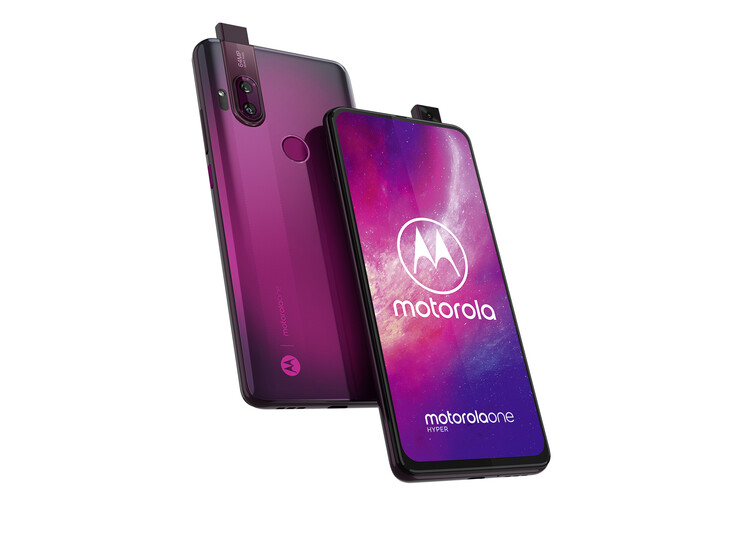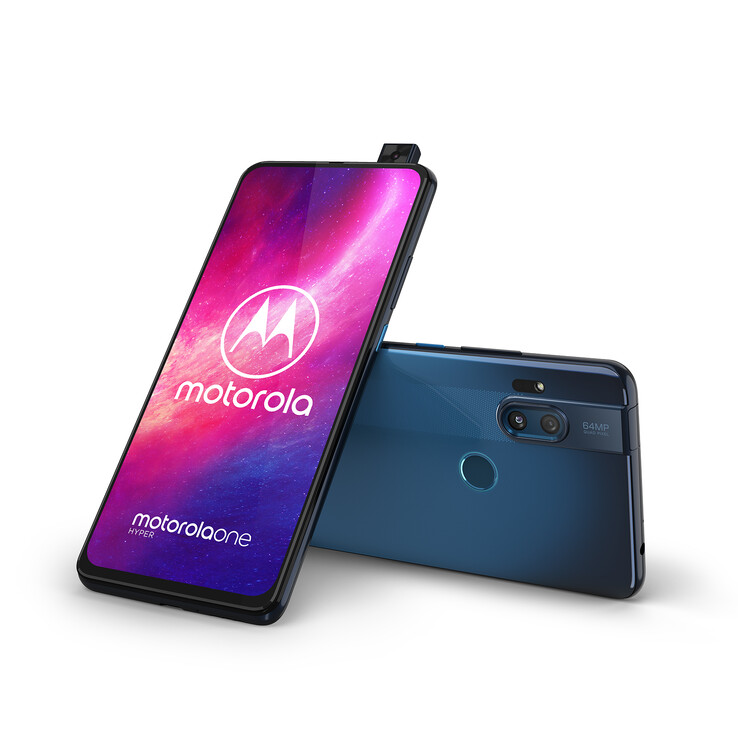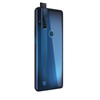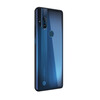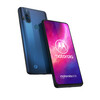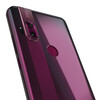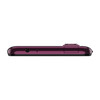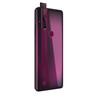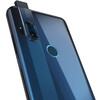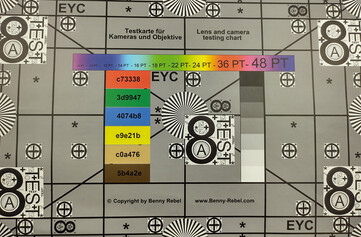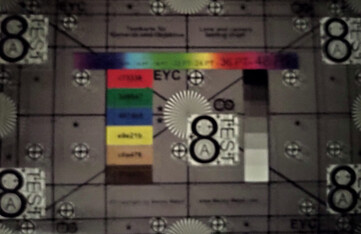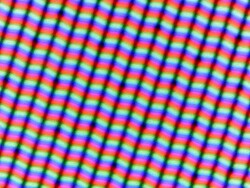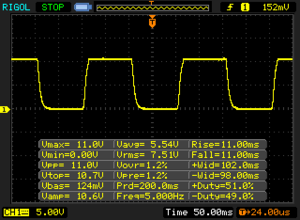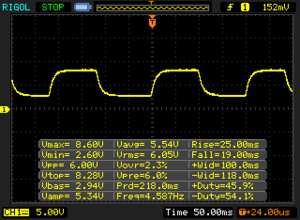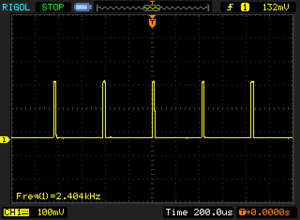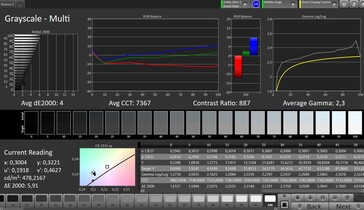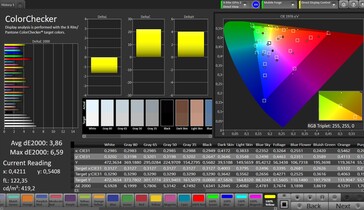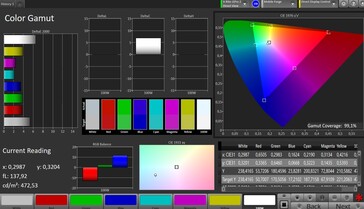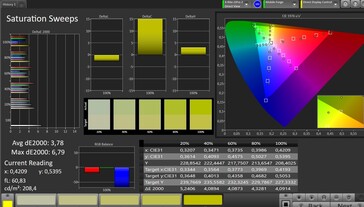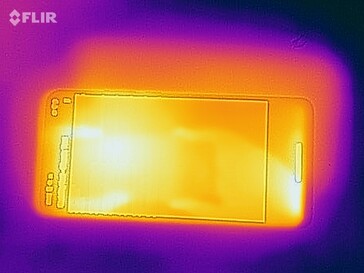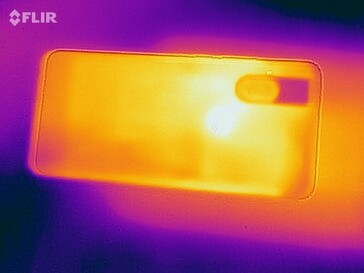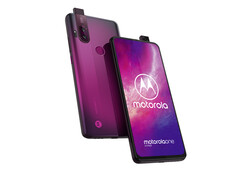Motorola One Hyper Smartphone Review – Middle class with retractable camera
Comparison Devices
Bewertung | Rating Version | Datum | Modell | Gewicht | Laufwerk | Groesse | Aufloesung | Preis ab |
|---|---|---|---|---|---|---|---|---|
| 80.3 % v7 (old) | v7 (old) | 01 / 2020 | Motorola One Hyper SD 675, Adreno 612 | 210 g | 128 GB UFS 2.0 Flash | 6.50" | 2340x1080 | |
| 78.6 % v7 (old) | v7 (old) | 11 / 2019 | Nokia 7.2 SD 660, Adreno 512 | 180 g | 64 GB eMMC Flash | 6.30" | 2340x1080 | |
| 89.4 % v6 (old) | v6 (old) | 08 / 2019 | Honor 20 Kirin 980, Mali-G76 MP10 | 174 g | 128 GB UFS 2.1 Flash | 6.26" | 2340x1080 | |
| 81.6 % v7 (old) | v7 (old) | 07 / 2019 | Xiaomi Mi 9T SD 730, Adreno 618 | 191 g | 64 GB UFS 2.0 Flash | 6.39" | 2340x1080 |
Case, Equipment and Operation - Heavy, but Chic
Depending on the country, the Motorola One Hyper is available in Deep Deas Blue, a Dark Blue, Fresh Orchid, a Wine Red or Dark Amber, a Brown Tone. In some countries the Motorola One Hyper is available exclusively on the Motorola website.
The Motorola smartphone offers a front without notch or display hole, as the front camera is moving out of the case. The chassis offers a reflective back with a recessed pattern, the camera module protrudes and is also visually highlighted. The fingerprint sensor, which unlocks the device reliably and quickly, is also located on the back. An LED light ring runs around it, which is used to display notifications.
At 210 grams, the Motorola One Hyper is not a light smartphone and is also more suitable for larger hands due to its dimensions.
128 GB UFS 2.0 memory is a great thing in this price range, often there are only 64 GB and usually only the slower eMMC flash. NFC is on board as well as fast WiFi 5, the Motorola One Hyper is also quite fast on the internet in our test with the reference router Linksys Nighthawk AX12.
| Networking | |
| iperf3 transmit AX12 | |
| Motorola One Hyper | |
| Nokia 7.2 | |
| Honor 20 | |
| Xiaomi Mi 9T | |
| iperf3 receive AX12 | |
| Nokia 7.2 | |
| Motorola One Hyper | |
| Xiaomi Mi 9T | |
| Honor 20 | |
Cameras - Good Image Quality
The dual camera on the back offers a standard 64 megapixel lens and a wide angle 8 megapixel lens. In the camera app, you can clearly see that both lenses use a different white balance, which is annoying. At least there is a hybrid zoom that works relatively continuously between the wide angle and the standard lens.
The huge resolution of the main camera is mainly used to combine four pixels into one and thus capture more light by using larger pixels. However, a special mode for ultra-high resolution images is also available. In standard mode, the camera takes good photos with lots of detail, good light output and good sharpness. In dark situations, the camera achieves a decent sharpness, but only a very slight brightening of the image.
In our laboratory tests under fixed light conditions, the fairly warm colour rendering of the main lens is noticeable and the sharpness of details is satisfactory. Even at a very low exposure, some details are still visible, but the clarity of the image suffers a lot.
For video recordings, which are possible up to 4K, the exposure adjusts quickly and quite appropriately, you can even use the hybrid zoom during recording, e.g. zooming out of a shot into wide-angle view. Switching between lenses is not completely invisible, but it's a nice effect in any case.
The front camera has a resolution of 32 megapixels, and takes really sharp pictures.
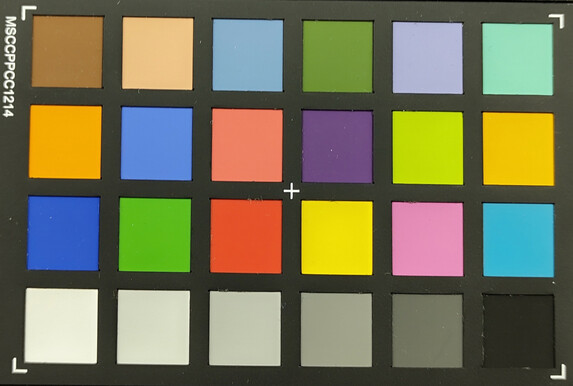
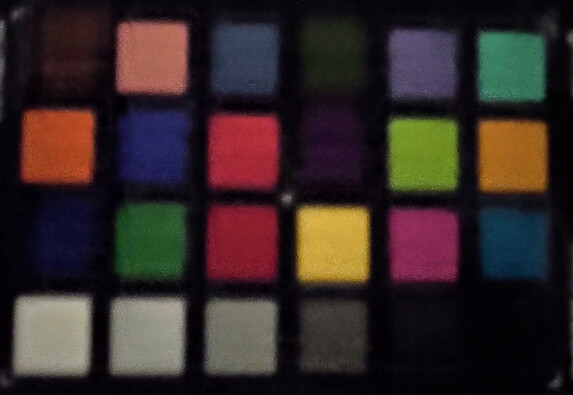
Display - Uneven Brightness
The display offers an extended FullHD resolution, which is usual for this price class. It is an IPS panel that can't keep up with most competitors in terms of brightness. It should be bright enough for everyday use, but if you are in very bright environments, you will notice the difference.
We measured PWM, but with a very high frequency and only up to 10% brightness, so there shouldn't be any problems for sensitive people. The distribution of brightness is rather moderately even, and with the naked eye you can see that one corner is considerably darker than the others when you look closely.
The black level is also rather average, the colours can be more or less saturated depending on the setting. The high saturation setting looks quite colourful, a lower setting gives a more natural picture impression. A clear blue cast is visible in our measurements with the CalMAN software, but the colour and grey scale deviations are rather small.
| |||||||||||||||||||||||||
Brightness Distribution: 78 %
Center on Battery: 455 cd/m²
Contrast: 858:1 (Black: 0.53 cd/m²)
ΔE ColorChecker Calman: 3.86 | ∀{0.5-29.43 Ø4.78}
ΔE Greyscale Calman: 4 | ∀{0.09-98 Ø5}
99.1% sRGB (Calman 2D)
Gamma: 2.3
CCT: 7367 K
| Motorola One Hyper IPS, 2340x1080, 6.5" | Nokia 7.2 IPS, 2340x1080, 6.3" | Honor 20 IPS, 2340x1080, 6.3" | Xiaomi Mi 9T AMOLED, 2340x1080, 6.4" | |
|---|---|---|---|---|
| Response Times | -5% | -9% | 88% | |
| Response Time Grey 50% / Grey 80% * (ms) | 44 ? | 48 ? -9% | 46 ? -5% | 4 ? 91% |
| Response Time Black / White * (ms) | 22 ? | 22 ? -0% | 24.8 ? -13% | 3.2 ? 85% |
| PWM Frequency (Hz) | 2404 ? | 2315 ? | 245.1 ? | |
| Screen | 5% | 30% | 34% | |
| Brightness middle (cd/m²) | 455 | 604 33% | 481 6% | 589 29% |
| Brightness (cd/m²) | 444 | 593 34% | 481 8% | 589 33% |
| Brightness Distribution (%) | 78 | 92 18% | 95 22% | 96 23% |
| Black Level * (cd/m²) | 0.53 | 0.4 25% | 0.55 -4% | |
| Contrast (:1) | 858 | 1510 76% | 875 2% | |
| Colorchecker dE 2000 * | 3.86 | 5.1 -32% | 1.1 72% | 2.5 35% |
| Colorchecker dE 2000 max. * | 6.59 | 10.3 -56% | 2.1 68% | 4.9 26% |
| Greyscale dE 2000 * | 4 | 6.4 -60% | 1.3 67% | 1.6 60% |
| Gamma | 2.3 96% | 2.23 99% | 2.12 104% | 2.24 98% |
| CCT | 7367 88% | 8149 80% | 6442 101% | 6544 99% |
| Total Average (Program / Settings) | 0% /
3% | 11% /
22% | 61% /
48% |
* ... smaller is better
Display Response Times
| ↔ Response Time Black to White | ||
|---|---|---|
| 22 ms ... rise ↗ and fall ↘ combined | ↗ 11 ms rise | |
| ↘ 11 ms fall | ||
| The screen shows good response rates in our tests, but may be too slow for competitive gamers. In comparison, all tested devices range from 0.1 (minimum) to 240 (maximum) ms. » 47 % of all devices are better. This means that the measured response time is similar to the average of all tested devices (20.2 ms). | ||
| ↔ Response Time 50% Grey to 80% Grey | ||
| 44 ms ... rise ↗ and fall ↘ combined | ↗ 25 ms rise | |
| ↘ 19 ms fall | ||
| The screen shows slow response rates in our tests and will be unsatisfactory for gamers. In comparison, all tested devices range from 0.165 (minimum) to 636 (maximum) ms. » 72 % of all devices are better. This means that the measured response time is worse than the average of all tested devices (31.6 ms). | ||
Screen Flickering / PWM (Pulse-Width Modulation)
| Screen flickering / PWM detected | 2404 Hz | ≤ 15 % brightness setting | |
The display backlight flickers at 2404 Hz (worst case, e.g., utilizing PWM) Flickering detected at a brightness setting of 15 % and below. There should be no flickering or PWM above this brightness setting. The frequency of 2404 Hz is quite high, so most users sensitive to PWM should not notice any flickering. In comparison: 53 % of all tested devices do not use PWM to dim the display. If PWM was detected, an average of 8121 (minimum: 5 - maximum: 343500) Hz was measured. | |||
Performance, Emissions and Battery Life - One Hyper with Lots of Power
The Qualcomm Snapdragon 675 is a quite potent midrange processor that can keep up well in our benchmarks. The comparable devices offer either as much or even less performance as the Nokia 7.2. The Honor 20 is only clearly ahead in terms of graphics performance.
If you look at the memory speeds, they are quite typical for UFS 2.0 memory when it comes to internal memory. The Honor 20 is also clearly ahead with its UFS 2.1 memory.
The Motorola One Hyper reads memory cards via the microSD slot, which can also be used as a SIM slot. So it is only possible to use either one SIM card and one microSD or two SIM cards. The speeds with our reference microSD Toshiba Exceria Pro M501 are average, but a bit slower than in the Nokia 7.2.
The smartphone can get a bit warm under load, but it never reaches unpleasant temperature ranges on the outer shell.
The loudspeaker can get quite loud, it offers a fairly balanced mixture, whereby there are slightly overemphasized trebles that you can also notice when listening to music. The sound is most powerful at full volume, underneath it becomes considerably thinner. A 3.5mm connector for analogue headphones is available.
The battery life is 12:33 hours. Not a bad value, but given the 4,000 mAh battery, even more would have been possible, as the Xiaomi Mi 9T shows. It should easily suffice for a working day, normal users should also manage 2 or 3 days without a power outlet. The quick charger with 27 watts can bring the Motorola phone quickly back to full charge, you don't have to wait longer than 1:30 hours for it.
| PCMark for Android | |
| Work performance score (sort by value) | |
| Motorola One Hyper | |
| Honor 20 | |
| Xiaomi Mi 9T | |
| Average Qualcomm Snapdragon 675 (9288 - 9522, n=3) | |
| Work 2.0 performance score (sort by value) | |
| Motorola One Hyper | |
| Nokia 7.2 | |
| Honor 20 | |
| Xiaomi Mi 9T | |
| Average Qualcomm Snapdragon 675 (7315 - 7950, n=4) | |
| GFXBench | |
| on screen Aztec Ruins Normal Tier Onscreen (sort by value) | |
| Motorola One Hyper | |
| Nokia 7.2 | |
| Honor 20 | |
| Xiaomi Mi 9T | |
| Average Qualcomm Snapdragon 675 (8 - 8.9, n=4) | |
| Average of class Smartphone (6.2 - 166, n=209, last 2 years) | |
| 1920x1080 Aztec Ruins Normal Tier Offscreen (sort by value) | |
| Motorola One Hyper | |
| Nokia 7.2 | |
| Honor 20 | |
| Xiaomi Mi 9T | |
| Average Qualcomm Snapdragon 675 (9 - 9.9, n=4) | |
| Average of class Smartphone (3.4 - 367, n=209, last 2 years) | |
| on screen Aztec Ruins High Tier Onscreen (sort by value) | |
| Motorola One Hyper | |
| Nokia 7.2 | |
| Honor 20 | |
| Xiaomi Mi 9T | |
| Average Qualcomm Snapdragon 675 (3.1 - 5.2, n=4) | |
| Average of class Smartphone (0.85 - 144, n=210, last 2 years) | |
| 2560x1440 Aztec Ruins High Tier Offscreen (sort by value) | |
| Motorola One Hyper | |
| Nokia 7.2 | |
| Honor 20 | |
| Xiaomi Mi 9T | |
| Average Qualcomm Snapdragon 675 (3 - 4.8, n=4) | |
| Average of class Smartphone (1.2 - 129, n=209, last 2 years) | |
| Motorola One Hyper | Nokia 7.2 | Honor 20 | Xiaomi Mi 9T | Average 128 GB UFS 2.0 Flash | Average of class Smartphone | |
|---|---|---|---|---|---|---|
| AndroBench 3-5 | -25% | 35% | -2% | 1% | 389% | |
| Sequential Read 256KB (MB/s) | 492.2 | 290.8 -41% | 829 68% | 492.7 0% | 530 ? 8% | 2223 ? 352% |
| Sequential Write 256KB (MB/s) | 190.8 | 161.4 -15% | 196.4 3% | 179.2 -6% | 212 ? 11% | 1838 ? 863% |
| Random Read 4KB (MB/s) | 129.4 | 79.6 -38% | 156.7 21% | 128.6 -1% | 130.6 ? 1% | 295 ? 128% |
| Random Write 4KB (MB/s) | 106.9 | 13.38 -87% | 157 47% | 107.8 1% | 101.2 ? -5% | 335 ? 213% |
| Sequential Read 256KB SDCard (MB/s) | 74.3 ? | 83.3 ? 12% | 68.3 ? -8% | |||
| Sequential Write 256KB SDCard (MB/s) | 53.6 ? | 64 ? 19% | 53.2 ? -1% |
Temperature
(±) The maximum temperature on the upper side is 42.3 °C / 108 F, compared to the average of 35.2 °C / 95 F, ranging from 21.9 to 247 °C for the class Smartphone.
(±) The bottom heats up to a maximum of 41.5 °C / 107 F, compared to the average of 34 °C / 93 F
(±) In idle usage, the average temperature for the upper side is 32.1 °C / 90 F, compared to the device average of 32.9 °C / 91 F.
Speakers
Motorola One Hyper audio analysis
(+) | speakers can play relatively loud (82.6 dB)
Bass 100 - 315 Hz
(-) | nearly no bass - on average 68% lower than median
(+) | bass is linear (0% delta to prev. frequency)
Mids 400 - 2000 Hz
(-) | nearly no mids - on average 68% lower than median
(+) | mids are linear (0% delta to prev. frequency)
Highs 2 - 16 kHz
(-) | nearly no highs - on average 68% lower than median
(+) | highs are linear (0% delta to prev. frequency)
Overall 100 - 16.000 Hz
(-) | overall sound is not linear (118.1% difference to median)
Compared to same class
» 87% of all tested devices in this class were better, 8% similar, 5% worse
» The best had a delta of 11%, average was 35%, worst was 134%
Compared to all devices tested
» 96% of all tested devices were better, 2% similar, 1% worse
» The best had a delta of 4%, average was 24%, worst was 134%
Honor 20 audio analysis
(±) | speaker loudness is average but good (81 dB)
Bass 100 - 315 Hz
(-) | nearly no bass - on average 20.8% lower than median
(±) | linearity of bass is average (12.9% delta to prev. frequency)
Mids 400 - 2000 Hz
(+) | balanced mids - only 4.3% away from median
(+) | mids are linear (4.2% delta to prev. frequency)
Highs 2 - 16 kHz
(±) | higher highs - on average 5.5% higher than median
(+) | highs are linear (5% delta to prev. frequency)
Overall 100 - 16.000 Hz
(±) | linearity of overall sound is average (22.3% difference to median)
Compared to same class
» 46% of all tested devices in this class were better, 7% similar, 47% worse
» The best had a delta of 11%, average was 35%, worst was 134%
Compared to all devices tested
» 64% of all tested devices were better, 6% similar, 30% worse
» The best had a delta of 4%, average was 24%, worst was 134%
Battery Life
| Motorola One Hyper 4000 mAh | Nokia 7.2 3500 mAh | Honor 20 3750 mAh | Xiaomi Mi 9T 4000 mAh | Average of class Smartphone | |
|---|---|---|---|---|---|
| Battery Runtime | |||||
| WiFi Websurfing (h) | 12.6 | 9.5 -25% | 10.9 -13% | 16.5 31% | 19.2 ? 52% |
Pros
Cons
Verdict – The Cameras Are Really Good
The Motorola One Hyper is a chic mid-range phone that has good performance, with a battery life that is on par with its class, doesn't get too warm, can display colors quite accurately and comes with good cameras. The case is also chic, the fingerprint sensor is fast and the LED ring on the back is a good idea.
In addition, there is the latest Android 10, which has hardly been changed by pre-installed software. The many and fast memory is also a plus point and the quick charging technology is fun because you don't have to wait long for a full battery.
The Motorola One Hyper is a midrange smartphone with good cameras and hardly any weak points.
But we can of course also complain: On the one hand, there is the strangely uneven brightness distribution on the screen, the different white balance of the two camera lenses, which is especially noticeable when zooming, and the Motorola One Hyper's heavy weight, which could be a deterrent for some buyers.
All in all, these are rather minor problems that can hardly cloud the overall good impression of the Smarpthone.
Motorola One Hyper
- 01/14/2020 v7 (old)
Florian Schmitt




